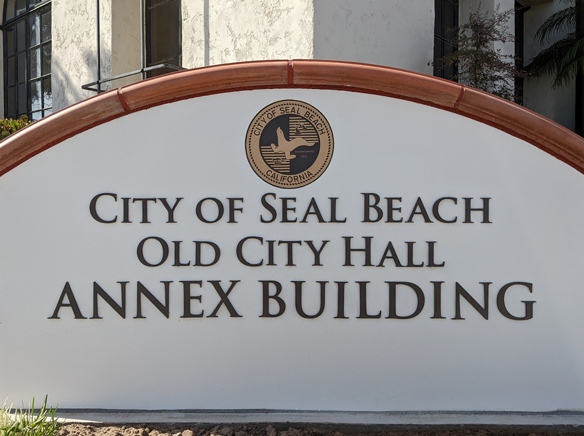Second of two parts.
Last week, the council approved the budget for the 2024-25 fiscal year, which began Monday, July 1. As part of the discussion, the council restored funding for porta-potties in city parks.
District Two Council Member Tom Moore asked about the differences between the current five-year budget forecast and last year’s forecast during the June 24 council discussion of the budget. Due to space limits, this article will only look at highlights from the discussion of the five-year forecast and the budget overall.
According to a slide shown during the June 24 council meeting, the updated five-year forecast projected a surplus of more than $33,000 for the fiscal year 2024-2025 budget, a deficit of more than $1.4 million for the 2025-26 budget, a deficit of more than $2 million for the 2026-27 budget, a deficit of more than $2.3 million for the 2027-28 budget and a deficit of more than $2.7 million for the 2028-29 budget. (For a look at the updated five-year forecast, taken from the June 24 agenda package, see this page.)
Last year’s budget five-year forecast projected a $20,183 surplus in 2023-24, a deficit of more than $1.6 million in 2024-25, a deficit of more than $3.3 million in 2025-26, a deficit of more than $3.3 million in 2025-26, and a deficit of more than $4.5 million in 2026-27, and a deficit of more than $5.5 million in 2027-28.
In other words, the current five-year forecast is projecting smaller deficits in future years than did last year’s five-year forecast.
Moore’s question
During the council discussion of the budget, Moore asked for confirmation that the five-year forecast was $5 million less for 2024-25 than for 2023-24.
“Yes, but if we added back any of the $6 million in deferrals it would be substantially more than what was in the previous forecast,” Arenado said.
Budget Background
As previously reported, the council had three budget workshops (the third specifically requested by the council at the end of the second workshop) before the budget was approved at the last meeting of last month.
At the start of that meeting, Finance Director Barbara Arenado told the council that the budget was balanced. She told the council that all city departments dealt with 30 rounds of changes to the budget. She specifically thanked the finance analyst who helped, prompting a round of applause from staff members in the room.
Arenado said this year the city began the budget process with a $6 million deficit.
“The budget is balanced for fiscal year 242-5 with revenue projections for the General Fund of $44 million,” Arenado said.
She said General Fund revenues grew 4.3% from the previous budget.
Discussing the five-year forecast, Arenado said the five-year forecast was resent during each budget cycle. She said consultant HdL recalculates their property tax assumptions based oon current data. “Last year they anticipated the interest rates were going to have a far more extreme impact on the city than it did and with today’s assumptions that are much different than last year, HdL increased their assumptions,” Arenado said.
She said the previous year’s assumptions were no longer valid.
According to Arenado, staff and the city’s consultants do not build into the forecast recessions or other unknown emergencies such as wars or disasters.
“The purpose of the five-year is to provide an outlook of the city’s General Fund finances over the next five years as updated with the budget and to make decisions early and plan for the future,” Arenado said.
“In the five-year, the growth in property tax, sales tax, and TOT [transient occupancy tax] is offset by reductions in charges for services and fines and forfeitures,” Arenado said.
“On the expenditure side, there’s an ongoing structural deficit,” Arenado said.
(In a May 17 email, Arenado explained the difference between a deficit and a structural deficit. “A budget deficit occurs when a City’s total expenditures exceed its total revenue in a specific fiscal period. A structural deficit, on the other hand, indicates an ongoing imbalance where recurring revenues are consistently insufficient to meet recurring expenditures.”)
Arenado said the structural deficit necessitated reductions in service levels across all departments.
A slide she showed summarized the budget expenditure overview, which included:
• Ongoing structural deficit
• $3 million in reductions in maintenance and operations.
• The reductions don’t fully address long-term liabilities.
Arenado said 40% of the city’s expenditures include salaries and benefits. (Those benefits include retirement.)
Again turning to the five-year forecast, Arenado said every action the city takes will modify the five-year forecast.
“Although 24-25 is now balanced, if no new revenue opportunities are included next year when we revisit the budget that position will need to be subsidized by the general fund and it will impact the future outlook,” Arenado said.
“The five-year does not include the many city-wide deferrals as discussed by each department,” Arenado said. She said those cuts were not sustainable long term.
During the public hearing on the budget, John William Kochevar said the city’s investments were “boring”.
“Is there any way to get some of those Investments local because I know boring basically means closest to the federal government money printer,” he said.
He asked if there was a way to get investments in higher risk/higher reward projects.
District Three Councilwoman Lisa Landau asked wasn’t there a government code that regulates investments to answer his question. Someone said yes.
Kochevar was the only member of the public to speak during the public hearing.
Sustarsic asked what exactly was a “public safety realignment”. She found the term in the section of the budget discussing the five-year forecast.
Arenado said that since Measure BB had passed, public safety had done some modifications and the city would continue to see them. (Seal Beach’s public safety includes the Police Department, Orange County Fire Authority services, and the Marine Safety Department.)
““I think there’s two questions,” said Seal Beach Police Chief Michael Henderson.
“The first one is locally here in Seal Beach what Public Safety realignment have we done even in this fiscal year and as you know we’ve reduced our overtime budget we’ve reduced our training budget. We’ve deferred hiring on one full-time position, one part-time
position, so we can continue to meet service needs,” Henderson said.
“I don’t know the context of what you’re referring to we when we talk in the
broader context of Public Safety realignment,” Henderson said.
According to Henderson, the state has imposed additional training and oversight requirements without providing funding.
Moore said he’d heard porta-potties would be removed from the city’s parks.
Arenado confirmed that they had been removed from the budget.
Moore said the gardeners in Edison Park use them and suggested that was something the council might reconsider.
Arenado said that was the council’s decision.
Moore asked if council would agree to keep the porta-potties in the park. District Five Councilman Steele said he had no objection. Councilwoman Landau said that was a quality-of-life issue.
Public Works Director Iris Lee said the porta-potties were slated for removal on June 28. She said staff would need direction from council to redirect funds for portable restrooms.
According to Arenado, there was a fund with a remaining balance of $33,000 in a city fund. The money for the porta-potties would come from that.
Moore said the last Water Master Plan was sin 2012. He requested an updated Water Master Plan.
Lee said updating a Water Master Plan takes of a year or more.
“We’re supposed to have one every 10 years, right?” Moore asked.
Lee said it is best practice to update a Water Master Plan every five to 10 years.
Concluding remarks
Moore suggested a town hall for residents and the council to get more feedback before the council had the budget workshops. He suggested a month or two in advance.
Moore said the third budget workshop was good because the council didn’t have much chance to talk at the first two workshops because there were a lot of presentations.
Moore also wanted the city to take a look at city pensions.
Steele thanked City Manager Jill Ingram for bringing the budget into alignment. He also thanked all the department heads.
Moore wanted to include a town hall as part of the motion to approve the 2024-25 budget.
Steele said he would support money for porta-potties, but he wasn’t sure about the rest.
Sustarsic suggested a separate motion.
Ingram said a separate motion was not necessary. “We’ve noted it,” Ingram said.
“In terms of doing it a couple months earlier, I think we just have to talk about um in terms of the timing when it would be appropriate to do that,” Ingram said.
“It may not be necessarily very efficient or effective to do it a couple months early before we actually know where we stand with the budget,” Ingram said.
“We may just need to extend our timeline out in terms of scheduling the budget workshops after the town hall meeting. But we’ve heard your directions,” Ingram said.
Moore moved approval of the budget with the change to the funding for porta-potties.
Steele seconded the motion.
The vote was unanimous.




